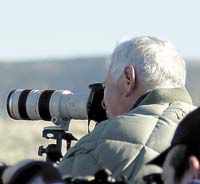| Cameras and binoculars were everywhere at Emma Park on Saturday. |
With binoculars, long-distance telephoto camera lenses and other viewing equipment in hand, more than a dozen members of the public joined Utah Division of Wildlife Resources personnel on Saturday to view an early morning wildlife show.
Just inside the Carbon County line, the group stood on the edge of Emma Park Road looking north toward a lek – a grassy ridge a few hundred yards away where a handful of male sage grouse were performing a ritual courtship dance.
For a few weeks every spring, males begin the strutting around sunrise and may continue for a few hours into the morning. Looking closely, viewers can also make out the less visible females sheltered among taller grasses and low brush near the hilltop.
The males, with their white breasts are more visible throughout the year. But as they strut on the lek, the males puff up their breasts, and flare their tail feathers. Periodically, a male will puff up his chest to draw attention. And as quickly as it puffs up, its chest flop back down to its body, making a flapping sound.
Even in mid-April, frost still forms at night at the 7,300-foot elevation where the viewers watch the mating ritual.
“It was only 12 degrees when I got up here,” said photographer Kimball Johnson. “I’m beginning to feel my fingers now.”
DWR personnel set up two viewing areas. From a small parking area near a livestock corral, wildlife officials said the grouse were backdropped by a herd of elk for part of the viewing. Later, a group of coyotes began approaching and the grouse fled from the ridge.
| Sage grouse strut their stuff on Saturday in Emma Park. The DWR planned the viewing day for the public. |
Farther down the road, spectators and officials lined the shoulders of the county road where birds stayed a little longer. But as temperatures warmed up, a few of the grouse fled and along with them, many of the spectators.
A few remaining grouse remained on the hilltop as a group of stragglers asked DWR officials for permission to venture closer to the ridge.
Armed with tripods, digital cameras powerful zoom lenses, the group of five crept slowly toward the ridge just east of the grouse.
The groups moved forward 10 paces, stopped to take a few photos, and slowly crept on. Just before the group reached the ridge, one of the grouse decides he has had enough and flies away south.
But the remaining male and female were oblivious to the approaching photographers. And from a few hundred feet away, the group could see the fowl more clearly. The mustard-colored crown of the male’s head and white markings on an otherwise brown body became more visible.
Soon the single remaining female flew from the ridge. The male remained, continuing the ritual mating dance. Slowly he calmed down and the white, puffed-up breast slowly went back to just a white strip between his wings. He stood on the ridge for a few moments before taking to the air and heading off to the south.
DWR personnel at the viewing area said strutting sage grouse are visible for a few weeks every year. During the day, they remain out of sight, shielded by sage brush stands as they feed and rest.
Wildlife officials reminded members of the public that sage grouse cannot be hunted without a permit. Even then, sage grouse can be hunted only in four designated areas of the state during a one-week hunt in September.

